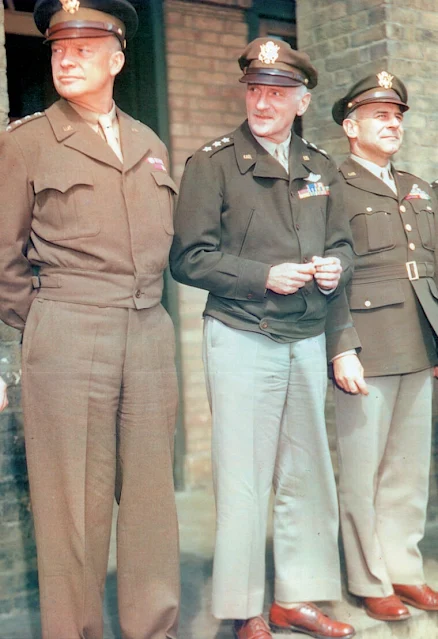 |
| B-17G 42-39867 'Hang the Expense II' (EP-E) aka 'Boeing Belle' (EP-Z). |
 |
| B-17G 42-39867 'Hang the Expense II' (EP-E) aka 'Boeing Belle' (EP-Z). |
 |
| Another view of the damage to the tail of B-17G 42-39867 'Hang the Expense II' (EP-E). |
 |
| Another view of the damage to the tail of B-17G 42-39867 'Hang the Expense II' (EP-E). |
 |
| B-17G 42-39867 (EP-E) after repair, February 29, 1944. |
 |
| Another view of B-17G 42-39867 (EP-E) after repair, February 29, 1944. |
 |
| Another view of the same group of aircraft as above. (Imperial War Museum FRE 6253) |
 |
| High above Berlin, Eighth Air Force B-17s drop their cargoes of destruction on February 28, 1945. |
 |
| Supreme Allied commander General Dwight D. Eisenhower (left) stands with General Carl Spaatz (center), head of Army Air Force Combat Command, and Eighth Air Force Commander General Jimmy Doolittle. |
 |
| B-24J serial number 42-73244 "Lakanooki" of the 374th Bomb Squad, 308th Bomb Group, 14th Air Force, which flew in the China-Burma-India Theater. |
 |
| More than 450 B-29s took part in a major raid on Yokohama. The bombers released incendiary and fragmentation ordnance over an area of 6.9 square miles. |
 |
| Following a Japanese raid on the U.S. airbase at Saipan, November 27, 1944, the tail section of a destroyed B-29 is visible as the rest of the bomber burns. |
 |
| A heavy pall of smoke surrounds a burning oil tank while a parked B-29 sits out of harm’s way following a Japanese air raid on Saipan, December 21, 1944. |
 |
| The Boeing B-29 Superfortress bomber rained devastation on major Japanese cities during the final months of World War II. |
 |
| First Lieutenant James E. Swett of the U.S. Marine Corps became a fighter ace flying the Grumman F4F Wildcat and survived his plane’s shoot down as well. |
 |
| An F4F Wildcat test pilot demonstrates the proper technique for deployment of a life raft after the Grumman fighter has been forced to ditch in the sea. |
 |
| A flight of Corsairs over a Japanese-held island, March 1944. |
 |
| Marine Major Theodore Olsen, commanding officer of VMF-313 (right), stands in front of his badly damaged Corsair. He was later killed in action. |
 |
| A Marine Corsair fires a salvo of rockets at Japanese positions on Okinawa. |
 |
| The victims of crash landings, these Marine Corsairs in a Leyte scrap yard were salvaged for parts. |
 |
| A squadron of Corsairs prepares to take off from an unidentified Pacific island airfield. |
 |
| Curtiss P-40F Warhawk fighters are being hoisted onto the USS Chenango at Pier 7, NOB Norfolk, Virginia, October 15, 1942. |
 |
| A Curtiss P-40F Warhawk (41-14305) fighter is being hoisted onto the USS Chenango at Pier 7, NOB Norfolk, Virginia, October 15, 1942. |
 |
| Wake Island raid, October 5-6, 1943. The Curtiss SOC that directed the firing in the bombing of Wake Island, October 5, 1943, is shown just as it has left the catapult of USS Minneapolis (CA-36). |
 |
| Ground crew of the 56th Fighter Group work on the engine of a P-47 Thunderbolt at Boxted air base, February 1945. |
 |
| B-26 41-17858 “Coughin’ Coffin” lost an engine to flak on its 50th mission, right wing nearly torn off in belly landing. Rebuilt and sent back to the States for a war bond promotion. |
 |
| A woman drills parts for a dive bomber at the Vultee Aircraft Corporation factory in Nashville, Tenn., in February 1943. |
 |
| A flight of 9th Air Force B-26 Marauders flying in formation. |
 |
| A B-26 Marauder (serial number 42-96191) nicknamed "The Milk Run Special" of the 397th Bomb Group at Steeple Morden, 1945. |
 |
| B-26 Marauders of the 344th Bomb Group fly in formation during a mission. |
 |
| Ground personnel of the 386th Bomb Group load bombs into a B-26 Marauder. |
 |
| Martin B-26 “Rosie O’Brady”. |
 |
| Martin B-26 “Six Hits and a Miss”. |
 |
| Martin B-26s including 43-34181 Y5-O, 49th BS, 344th BG. |
 |
| Martin B-26 42-96153. |
 |
| Grumman F4F Wildcat and Douglas SBD Dauntless on USS Wasp, 1942. |
 |
| Grumman F4F Wildcat in pre-war markings. |
 |
| F6F Hellcats on the USS Cowpens (CVL-25), January 1944. |
 |
| De Havilland Mosquito, USAAF 25th Bomb Group. |
 |
| As the USS Missouri (BB-63) turns, her Kingfisher lands in her slick, taxis to her side. |
 |
| Bell P-39N Airacobra (42-9719 ) USAAF, 1943. |
 |
| Bell P-39 Airacobra, USAAF, ground crew loading 20mm rounds for the nose-mounted cannon and .50 cal. rounds for the wing machine guns. |
 |
| Bell P-39 Airacobras, USAAF. |
 |
| Republic P-47D Thunderbolt, USAAF. |
 |
| A North American Aviation painter cleans the tail assembly of a P-51 Mustang. |
 |
| B-17 "The Green Banana". |
 |
| B-17G radio compartment. |
 |
| North American NJ-1 US Navy. |
 |
| The Waco CG-3A was the USAAF's first production combat glider. The pilot and infantrymen climbed out through the hinged canopy upon landing. |
 |
| Waco CG-3A light transport glider at Wright Field, 1943. |


















